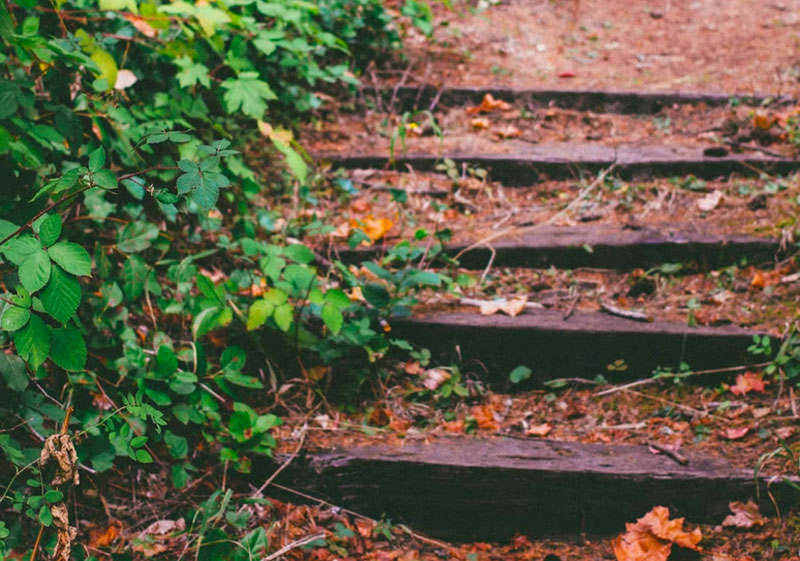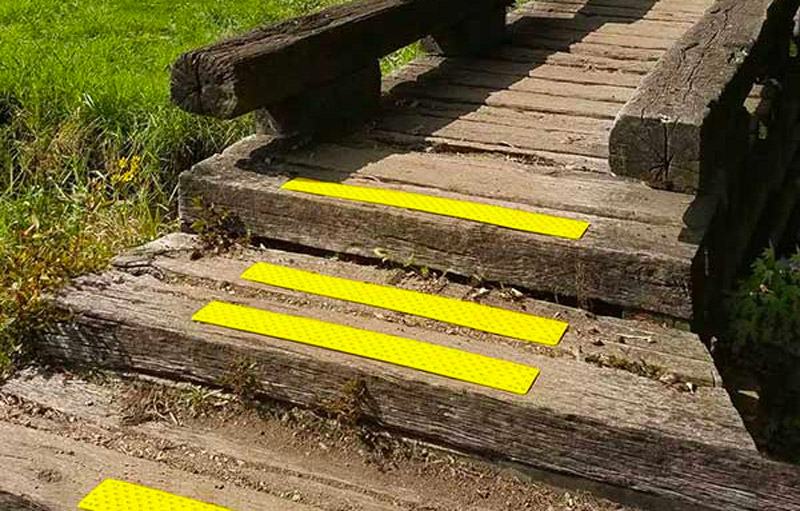Stairs & Decks, Safety Concerns
Safe Landscaping Steps for Your Hillside Home
For those fortunate enough to own one, a wooded hillside home can offer naturally dramatic views. Standing on a backyard deck in the morning, underneath a canopy of green, looking out over the morning mist – could there be a more calming, wonderful existence? Imagine still that your property extended downwards into the woods or perhaps towards a pond below. Who wouldn’t want to be able to take a stroll down the hill, coffee in hand, to be a part of the beauty that surrounds your hilltop home?
For homeowners who find peace in the natural magnificence that envelops their home, a walking path throughout the grounds is much needed. For lots with varying terrain or hills, the path will convert into steps at some point. When constructing these steps, you want something that won’t distract from the foliage and natural elements of your landscaping. So how does one go about building steps into a hill that are both safe and pleasing to the eye?
Building Safe Steps into a Hill
Homeowners can get really creative when it comes to designing steps on raised terrain. Some designs involve creating large squares in the terrain with the wood to make gradual steps or stacking the wood to more resemble a staircase. After deciding how the steps should look, it’s time to build. One of the most appealing aspects of creating a stairway on raised terrain is that many homeowners take it on as a DIY project. YouTube is filled with videos just like this one that guides you through the entire process. If you’re not the handiest, many landscaping and construction companies can handle the building for you.
Whether doing it yourself or hiring an expert, you’ll need to decide what type of wood you will want to use. The two most popular wood choices for building steps on raised terrain are landscaping timbers or railroad ties. While similar in shape and function, each lumber choice presents different benefits.
Landscaping Timbers
Pressure-treated landscaping timbers can be found at almost any hardware store and are used for a variety of landscaping projects. (photo) Many homeowners use them to create fencing, garden plots, or flower beds. Their squared-off shape also makes them perfect for constructing steps into raised terrain. When using landscaping timbers in your yard, it is important to ensure that the timbers have been treated with preservatives so that they will resist rotting, termites, and fungus growth. The preservatives are most often times organic compounds, meaning they can be safely used in the soil without damage to surrounding gardens. On average, landscaping timbers will last anywhere from 7 years to even 20 years before needing to be replaced.
Railroad Ties
While most recognizable on the nation’s railways, railroad ties have found a second life in landscaping projects. Used railroad ties are sold at landscaping supply stores and can also be found at some big box hardware stores as well. Railroad ties are treated with creosote to preserve the wood and prevent it from rotting. Unlike landscaping timbers, the creosote can leech into the surrounding soil and potentially contaminate surrounding gardens. If you are going to use railroad ties for any landscaping projects, be sure that they are used in areas away from edible gardens.

When compared to landscaping timbers, railroad ties are around the same price and can last relatively the same amount of time (7-20 years). When it comes to aesthetics, some owners choose railroad ties based solely on their appearance. They have a certain vintage and rustic quality that can add a nice touch to landscaping designs. Because most railroad ties are used, some homeowners also like the idea of giving new life to something that would otherwise end up in a landfill.
Slip and Fall Hazards on Wood Steps
Regardless of whether the steps are made of landscaping timbers or railroad ties, wood will become slippery outdoors. The three main culprits that create slippery and unsafe conditions on wood steps are moisture, debris, and degradation.
Moisture
Moisture can be present on your outdoor stairs in a multitude of ways. Moisture in the form of rain, sleet, ice, or snow is unavoidable outside. Simple morning dew or winter frost on the steps can also create slippery and dangerous conditions. If the steps are slightly bowed or have crevices like the used railroad ties, water can sit in small puddles on the steps.
Debris
Like moisture, debris cannot be avoided outdoors. Common debris that can become slip and fall hazards on steps are grass clippings, fallen leaves, mud, or moss growing on the steps. If moisture is present on the steps for a prolonged period of time, mold and mildew can also being to grow on the steps.
Degradation and Decay of Wood
Even when the wood is treated with preservatives, fungal decay may occur after a few years especially if the wood is exposed to long periods of moisture. When the wood starts to decay, it starts to offer a less solid step. Both landscaping timbers and railroad ties can last 10 years a more, but over time, especially under heavy foot traffic, the wood may incur some damage. Chipping edges of the wood can become a serious slip and fall hazard.
Making Timber and Railroad Tie Steps Safe
Slippery outdoor stairs can be extremely dangerous whether it be due to moisture, debris, degradation, or all the above. Luckily, there are ways to prevent slips and falls on your new beautifully constructed steps. The best way to mitigate slip and fall hazards is to install some sort of non-slip solution. However, not all solutions provide the same protection.
Why Peel-and-Stick Grit Treads Are Unsafe
Present at virtually every hardware or big box store, peel and stick grit stair treads appear to be the quickest and easiest way to make stairs non-slip. However, these grit treads do not hold up in outdoor conditions. First, the grit surface is too low-profile that it will not be able to provide traction when covered with debris like grass clippings or leaves. Second, the non-slip traction the grit provides is severely diminished when wet. If the grit surface is covered by a layer of frost, sleet, or snow, the grit is virtually useless in providing any traction.
As moisture begins to seep into the wood beneath the tread, the adhesive used to keep the tread in place will begin to degrade. Exceptionally warm conditions can also cause the adhesive to fail. After all, peel-and-stick grit treads usually only last about six months to a year in outdoor conditions before they start peeling off. A peeling tread can also become a dangerous slip and fall hazard on the stairs, as it can easily be tripped over.
The Best Non-Slip Solution for Slippery Outdoor Stairs
Of course, we think the most effective way to prevent slips and falls on outdoor stairs is to install a lifelong non-slip solution like HandiTreads. HandiTreads Non-Slip Stair Treads and Stair Nosings are constructed of aircraft-grade aluminum, which makes them exceptionally durable and long-lasting. So durable in fact that they come with a lifetime residential warranty.

Moisture is No Match
The surface of HandiTreads Stairs Treads and Nosings feature patented raised buttons. The holes within these buttons allow moisture like rain, sleet, and dew to fall through instead of collecting on top of the tread. The buttons also allow the tread to dispel up to an inch of water, ice, or snow to be dispelled from the surface when stepped on. Since the treads and nosings are installed by screwing them into the wood step, no amount of moisture can interfere with the placement and longevity.
Debris Can’t Interfere
Whether it be dirt, lawn clippings, or leaves, the patented surface of HandiTreads aluminum stair treads and nosings provides exceptional traction. Because the surface isn’t completely flat, a solid connection is made between the tread or nosing and shoe, even through debris. Still, it’s a good idea to brush the grass after mowing or raking up leaves in the autumn to ensure the treads or nosings can provide optimal non-slip protection.
Adds Additional Structural Support
While HandiTreads aluminum solutions cannot reverse any decay or degradation that has occurred on the wood, HandiTreads Non-Slip Stair Nosings can improve the structural integrity of each stair tread. Since HandiTreads Nosings wrap around the front edge of the wood step, they prevent pieces of wood from breaking off of the edge and creating slip and fall hazards. Once installed, the nosings can increase the life of landscaping timbers or railroad ties by stabilizing the wood step and protecting it from additional wear and tear.
Doesn’t Sacrifice Beauty for Safety
After designing and constructing a gorgeous stairway into the raised terrain on your home lot, the last thing you want to do is to cover it with bulky or ugly treads. HandiTreads aluminum stair treads and nosing provide unbeatable non-slip safety while also remaining low-profile at .225” thick. The aluminum non-slip treads and nosings are available in multiple shades to suit a wide variety of applications. The “Chestnut Brown,” “New England Gray,” and “Obsidian Black” shades are perfect for use on natural or painted landscaping timbers or railroad ties as they either blend in with or complement the earth tones of the wood. The “Safety Yellow” shade adds additional slip and fall protection as it draws the eye in when walking, promoting careful steps.
Conclusion
The only thing better than having a beautiful outdoor stairway constructed of railroad ties or landscaping timbers is that the stairways also be safe to use year-round. HandiTreads aluminum non-slip solutions create unbeatable traction in outdoor conditions throughout every season, letting you enjoy your beautiful landscaping without risking slip and fall injuries.
